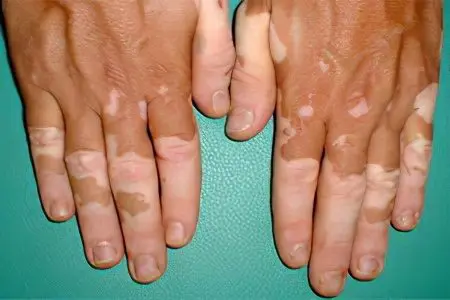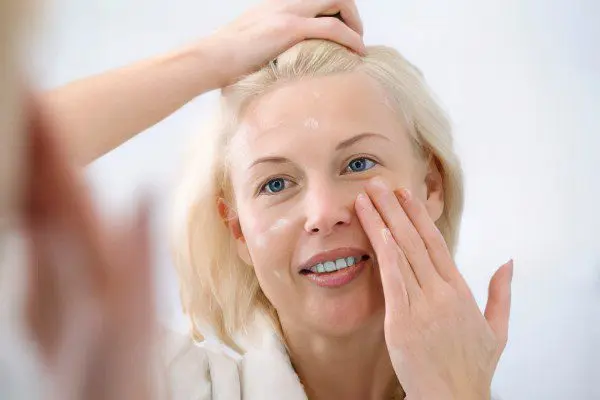Contents
Vitiligo – white patches on the skin
Vitiligo is a type of skin disease when the dermis loses natural pigmentation against the background of the destruction of melanin. As a result of this process, some areas of the skin lose color, which creates the effect of white spots or variegation. The disease has been known since ancient times, and in Rus’ among the common people it was called “dog”, which is most likely due to the appearance of the patient.
In medical practice, in addition to the name “vitiligo”, you can find another definition of this skin pathology, which sounds like leukoderma. If we turn to Latin, we can understand the origin of this word, in translation it means white skin.
As for statistics, according to some data, up to 1% of the world’s population suffers from vitiligo. The disease does not depend on a specific population, however, in dark-skinned people, the spots are more noticeable. Most often, the disease manifests itself at the age of 10 to 30 years, this period accounts for up to 50% of all cases of pathology.
Vitiligo symptoms
The main symptom of the disease is the appearance of spots on the skin that have a milky white color and clearly defined boundaries. The most susceptible to vitiligo are such parts of the body as the face (the area around the mouth, ears, eyes, nose), arms and legs (their back side, fingertips, elbows, feet, knees), the groin area and the perianal area. Spots can appear on the scalp, including in the area of the beard and mustache in males.
There are several types of spots, the following types of depigmentation can be noted:
At the point of transition of the skin subject to the pathological process to healthy, a pigmented contour is observed, the spots themselves have three colors.
Spots of four colors, which are limited by a border with pronounced pigmentation.
Spots are inflamed areas that are limited to a slightly raised shaft.
Spots that have a bluish color.

In addition, the disease may be accompanied by the following symptoms:
Alopecia nest form;
Choreoretinitis, in which the back of the eye and retina become inflamed;
Graying of hair or their lightening in areas affected by vitiligo;
Scleroderma;
Psoriasis;
Lichen planus;
Chronic gastrointestinal diseases;
In the affected areas, sweating processes are disturbed, the skin stops responding to cold and other irritants, muscle-hair and vasomotor reflexes disappear;
Vitiligo is often accompanied by various kinds of dermatitis;
Decreased functionality of the liver to resist toxins.
As for other subjective symptoms, the patient does not experience them and for the most part suffers only from a cosmetic defect. Therefore, people with this type of skin disease should avoid contact with the sun, as spots stand out more on tanned skin.
Depending on the localization of the pathological process, it is customary to distinguish a localized clinical form of vitiligo, when pathological foci are located on a certain area of the skin:
Mucous leukoderma, when mucous membranes are included in the affected area;
Segmental leukoderma, when the foci are located on a skin area that is supplied by a single nerve (cranial or spinal cord);
Focal leukoderma, when the spots occur singly, are localized in one or two skin areas.
Separately, we can distinguish a generalized form of vitiligo, which manifests itself in the fact that skin changes are quite extensive:
Acrofacial leukoderma, when the face and limbs are included in the pathological process;
Vulgar leukoderma, when the foci of the disease are located throughout the body;
Total or universal leukoderma is characterized by the fact that extensive areas of the skin are affected, up to 80%;
Mixed leukodkermia, when there is a combination of acrofascial and vulgar forms of the disease, or segmental, vulgar and acrofascial forms.
Causes of Vitiligo

Vitiligo is not born, this skin pathology begins to form under the influence of a number of external and internal factors. Moreover, the disease rarely manifests at an early age, namely up to 10 years. A connection was established with the debut of vitiligo and periods of increased solar activity in summer and spring.
Among the reasons provoking the development of the disease can be identified:
Autoimmune failures in the body are factors provoking the development of the disease. In this case, there is a malfunction in the functioning of the immune system and antibodies produced to destroy foreign agents begin to affect healthy tissues. Such conclusions about the relationship between vitiligo and autoimmune processes were made on the basis of the fact that people with skin lesions often have concomitant rheumatoid arthritis, thyroid disease, systemic lupus, etc.
The link between vitiligo and genetics has been proven experimentally. Scientist R. Spitz, working at the University of Colorado, has established a family predisposition to the development of this skin pathology. In addition, it has been scientifically proven that if a person has brown eyes, then the risk of developing the disease is higher than that of owners of gray and blue eyes.
endocrine gland. Serious disruptions in the work of the endocrine gland, as well as fluctuations in hormone levels, can provoke the onset of the disease. This group of causes will be combined into neuroendocrine. In addition, disturbances in the work of the pancreas, ovaries, pituitary gland and adrenal glands can have an impact.
Trophic disorders of the skin, which are caused by its various injuries (burns, including solar ones, scars and microtraumas). Vitiligo begins to form in previously damaged areas, as in these places an inflammatory reaction is triggered that has an autoimmune component. In this case, the cells that produce melanin are destroyed. At the same time, the more often a person exposes the skin to sunlight, the faster the process of depigmentation develops. That is, trophic disorders are another reason for the formation of vitiligo.
Taking certain medicines can provoke the onset of the pathological process.
Liver diseases that lead to stagnation of bile and changes in the parenchyma of the organ, which has a direct impact on the development of vitiligo.
Gastrointestinal diseasessuch as dysbacteriosis, malabsorption syndrome. Violation of the process of absorption of enzymes leads to the fact that the skin does not receive the necessary nutrients (zinc, copper, manganese, magnesium) for the normal formation of melanin.
Exposure to various chemicals on the skin. These can be low-quality cosmetics, phenol and reagents containing it, formaldehyde, etc.
Doctors rightly believe that vitiligo is the body’s most powerful signal of trouble in general. Indeed, often the disease starts after a viral infection, after intoxication, after a physical injury, especially after a head injury.
Thyroid gland as the cause of vitiligo
The figures show that disorders in the functioning of the thyroid gland cause the development of vitiligo. So problems with this organ are observed on average in 10,4% of patients with this skin pathology.
Among the diseases associated with thyroid disorders in vitiligo are:
Oats 1 and 2 degrees, without changes in thyroid function is very common, the number of patients reaches 86%. At the same time, there is an increase in TSH, AT TG and AG TPO hormones, against the background of a decrease in T4.
12% of patients with vitiligo have hyperthyroidism. In this pathological process, there is an increased production of hormones with all the ensuing consequences: weight loss, anxiety, nervousness, increased blood pressure, etc.
Gipotireoz in vitiligo, it is much less common, in only 2% of patients. In this case, such symptoms are observed as: a decrease in pressure, lethargy, fatigue, passivity.
As can be seen from the above statistics, the relationship between vitiligo and thyroid dysfunction is obvious.
Vitiligo stages
It is customary to distinguish several stages of the disease. Among them are:
progressive stage of the disease. This stage is spoken of when, within three months, there is a significant increase in the size of the spot, the growth of old depigmented areas begins, or all new formations appear. Vitiligo can progress slowly, with new lesions appearing next to the first spot over several months. Slow progression is considered to be the natural development of the disease. However, there is also fulminant vitiligo. In this case, the patient has an increase in the number of spots throughout the body for several weeks.
initial stage, in which a single spot is formed on the skin. Depending on the nature of the disease, this stage will later move into a progressive, stable or repigmentation stage.
stationary stage, which is characterized by the fact that the patient has one spot on the skin, which is in a stable condition. It does not grow for a long time period, new formations do not appear.
repigmentation stage. Most often, this stage is observed with the spontaneous formation of a spot caused by therapeutic measures, for example, taking certain medications. Unfortunately, independent and complete repigmentation in this form of skin disease is extremely rare.

Why is vitiligo dangerous?
It is generally accepted that this disease does not pose a direct threat to human life or health. However, vitiligo itself is most often the result of any disturbances in the body, which should not be ignored.
Therefore, if a person has vitiligo, you should pay attention to:
The functioning of the thyroid gland.
Taking medications, they may not be suitable and require immediate replacement.
For the presence of other skin diseases, in particular, psoriasis, baldness, etc.
On malfunctions of the immune system and on the factors provoking these disorders. In addition, there is evidence of a link between vitiligo and diabetes mellitus.
For frequent stress or mental instability.
On the lack of nutrients in the body.
Often vitiligo is observed with pneumonia, progressive myopia.
Therefore, if, in addition to vitiligo, a person is concerned about any other accompanying symptoms, this must be reported at the doctor’s appointment. In addition, patients often need psychological help, since such a pronounced cosmetic defect can lead to psychological trauma, depression, the development of an inferiority complex about their own appearance, etc.
Is vitiligo transmitted?

Is vitiligo hereditary?
The question of whether the disease is inherited has been repeatedly studied by various scientists. There is no consensus, but most studies indicate that there is a certain combination of genes that is responsible for the manifestation of vitiligo in members of the same family. Therefore, it is generally accepted that the risk of hereditary transmission varies from 15 to 40%.
But at the same time, spots are not formed without fail, but only under the influence of risk factors. Therefore, a child of parents who suffer from vitiligo can live a lifetime without experiencing the symptoms of this disease. However, children with a positive family history are at increased risk.
Can vitiligo be transmitted from person to person?
The answer to this question is unequivocally negative. This disease is not infectious and a person suffering from it does not pose a danger to others in terms of infection. Therefore, you can fearlessly communicate with people who have spots on the skin of the corresponding origin.
How and how to treat vitiligo?

If one or more white spots appear on the skin, then you need to go to an appointment with a dermatologist. He will examine the skin with a specialized lamp and determine the nature of depigmentation. If necessary, material will be taken to clarify the diagnosis. These procedures are important, as it is necessary to be able to distinguish vitiligo from other skin diseases.
With regard to therapy, despite the cases of complete and spontaneous healing from vitiligo available in medicine, there is a high risk that the disease will progress without the availability of appropriate treatment. Due to the fact that pathology is often accompanied by concomitant diseases, it is important to correctly use drugs of various groups.
Treatment with glucocorticoids (means aimed at suppressing autoimmune processes and allergic reactions) is indicated for localized and generalized forms of the disease.
Systemic therapy is aimed at eliminating hormonal disorders, at removing patients from depression, at eliminating mental and other diseases of the nervous system, which are often triggers in the development of vitiligo. It is important that the patient makes up for the deficiency of trace elements and vitamins. Therefore, he is shown the appointment of complexes containing ascorbic acid and copper in their composition. Also, a doctor may prescribe antioxidants and immunomodulators.
[Video] Doctor-dermatovenereologist of the highest category Bobchinskaya I. N. – how and how to treat vitiligo at home:









